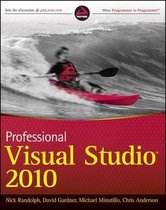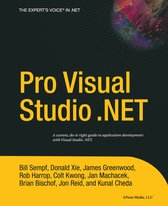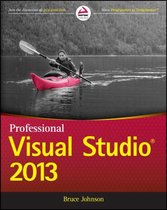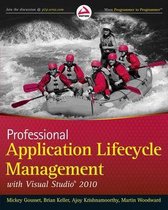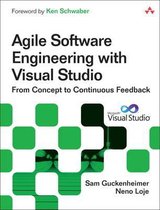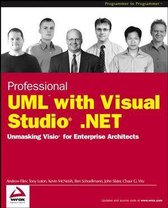Professional Visual Studio Extensibility
Afbeeldingen
Sla de afbeeldingen overArtikel vergelijken
Auteur:
Keyvan Nayyeri
Keyvan Nayyeri
- Engels
- Paperback
- 9780470230848
- 24 maart 2008
- 552 pagina's
Samenvatting
Visual Studio is a development IDE created by Microsoft to enable easier development for Microsoft programming languages as well as development technologies. It has been the most popular IDE for working with Microsoft development products for the past 10 years. Extensibility is a key feature of Visual Studio. There have not been many books written on this aspect of Visual Studio. Visual Studio Extensibility (VSX) can be considered a hard topic to learn for many developers in comparison with most .NET related topics. Also, its APIs are very complex and not very well written. Some may refer to these APIs as dirty because they do not have good structure, naming convention, or consistency. Visual Studio is now 10 years old. It was created during the COM days for COM programming but later migrated to .NET. However, Visual Studio still relies heavily on COM programming. It was revamped when moving to the .NET platform but still contains its COM nature; this fact is what makes it harder for .NET developers to work with VSX. Because it is an older product built on two technologies, it has produced inconsistency in code. Although there are problems with the current version of VSX, the future looks bright for it. The many different teams working on the software have been moved into one umbrella group known as the Visual Studio Ecosystem team. Throughout the past 10 years Visual Studio has continued to grow and new extensibility features have been added. Learning all of the options with their different purposes and implementations is not easy. Many extensibility features are broad topics such as add-ins, macros, and the new domain-specific language tools in Visual Studio. Learning these topics can be difficult because they are not closely related to general .NET programming topics. This book is for .NET developers who are interested in extending Visual Studio as their development tool. In order to understand the book you must know the following material well: Object-oriented programming (OOP), the .NET Framework and .NET programming, C# or Visual Basic languages, some familiarity with C++, some familiarity with XML and its related topics, and Visual Studio structure and usage. A familiarity with COM programming and different .NET technologies is helpful. The aims of this book are to: * Provide an overview of all aspects of VSX * Enable readers to know where/when to use extensibility * Familiarize readers with VS Extensibility in detail * Show readers the first steps and let them learn through their own experiences * Use examples, sample code, and case studies to demonstrate things in such a way that helps readers understand the concepts * Avoid bothering readers with long discussions and useless code samples In order to use this book, and get the most out of it, there are some technical requirements. You must have the following two packages installed on your machine to be able to read/understand the chapters and test code samples: * Visual Studio 2008 Team System Edition (or other commercial editions) * Visual Studio 2008 SDK 1.0 (or its newer versions) You will need to buy Visual Studio 2008 to register for an evaluation version. The Free Express editions of Visual Studio do not support the extensibility options. The Visual Studio SDK is needed in order to read some of the chapters in the book and can be downloaded as a free package. The operating system doesn't matter for the content of the book, but all code was written with Visual Studio 2008 Team System Edition in Windows Vista x86. Chapters 1, 2, and 3 will give you an introduction to the basic concepts you need to understand before you can move on to the rest of the book. Chapter 4 discusses the automation model, which is an important prerequisite for many of the chapters in the book that focus on add-ins, macros, and VSPackages. Chapters 5-14 will utilize add-ins in a case study to learn about the main responsibilities of the automation model and some of the more common techniques used in VSX development. Each of the following chapters is dedicated to a specific extensibility option; they are independent of one another and you can read them in any order. It is important to read chapters 4-14 before you begin reading about the specific extensibility options. Chapter 5 contains a walk-through of the Add-in Wizard and describes its steps. Chapter 6 will show you the anatomy of add-ins and explain how to create add-ins and how they work. Chapter 7 discusses how to manipulate solutions, projects, and project items via your code to build add-ins. Chapter 8 shows you how to deal with documents and code editors in your add-ins. Chapter 9 explains how to work with programming codes and how to manipulate their elements. Chapter 10 describes some ways to work with user interface elements, Windows Forms, and controls via code in your add-ins. Chapter 11 discusses the Tools Options page and uses add-ins as the case study to show you how to create your own Tools Options pages. Chapter 12 teaches you how to debug and test your add-ins. Chapter 13 shows you how to deploy your add-ins. Chapter 14 completes the discussion about add-ins by talk about resources and localization of add-ins. Chapter 15 discusses a new feature in VS 2008: the Visual Studio Shell. Chapter 16 talks about domain-specific language tools; you will learn how to build them and see a quick overview of DSL tools. Chapter 17 discusses debugging and how to extend debugging features. Chapter 18 talks about VSPackages as a way to extend VS functionality and add something new to its existing packages. Chapter 19 teaches you what a code snippet is and how to write and manage code snippets in Visual Studio to make your coding process easier. Chapter 20 talks about VS project templates and starter kits and how to write your own project templates. Chapter 21 focuses on MSBuild and writing custom builds for Visual Studio and .NET applications. Chapter 22 discusses Visual Studio macros in detail and explains how to build a Visual Studio macro. Keyvan Nayyeri is a software architect and developer. He has a Bachelor of Science degree in applied mathematics. His main focus is on Microsoft development technologies and their related markup languages. Nayyeri is also a team leader and developer for several .NET open-source projects; this includes writing code for special purposes. He holds an MVP award for Comunnity Server. He recently co-authored Wrox Professional Community Server (2007).
Productspecificaties
Wij vonden geen specificaties voor jouw zoekopdracht '{SEARCH}'.
Inhoud
- Taal
- en
- Bindwijze
- Paperback
- Oorspronkelijke releasedatum
- 24 maart 2008
- Aantal pagina's
- 552
- Illustraties
- Nee
Betrokkenen
- Hoofdauteur
- Keyvan Nayyeri
- Tweede Auteur
- Keyvan Nayyeri
- Hoofduitgeverij
- John Wiley And Sons Ltd
Overige kenmerken
- Extra groot lettertype
- Nee
- Verpakking breedte
- 190 mm
- Verpakking hoogte
- 31 mm
- Verpakking lengte
- 232 mm
- Verpakkingsgewicht
- 832 g
EAN
- EAN
- 9780470230848
Je vindt dit artikel in
- Categorieën
- Taal
- Engels
- Boek, ebook of luisterboek?
- Boek
- Beschikbaarheid
- Leverbaar
- Studieboek of algemeen
- Algemene boeken
Kies gewenste uitvoering
Bindwijze
: Paperback
Prijsinformatie en bestellen
De prijs van dit product is 37 euro en 78 cent. Dit is een tweedehands product.Alleen tweedehands
Goed
.
.
1 - 2 weken
Verkoop door
BAY EXPRESS
- Bestellen en betalen via bol
- Prijs inclusief verzendkosten, verstuurd door BAY EXPRESS
- 30 dagen bedenktijd en gratis retourneren
Shop dit artikel
Rapporteer dit artikel
Je wilt melding doen van illegale inhoud over dit artikel:
- Ik wil melding doen als klant
- Ik wil melding doen als autoriteit of trusted flagger
- Ik wil melding doen als partner
- Ik wil melding doen als merkhouder
Geen klant, autoriteit, trusted flagger, merkhouder of partner? Gebruik dan onderstaande link om melding te doen.


